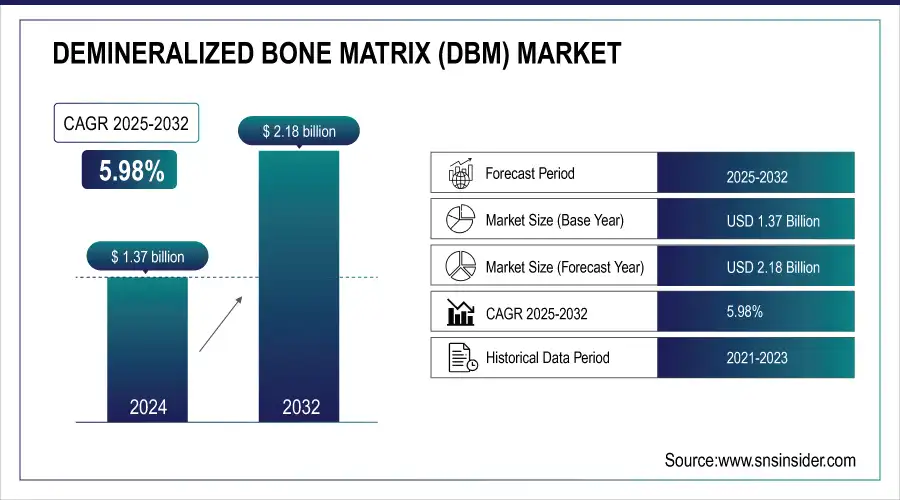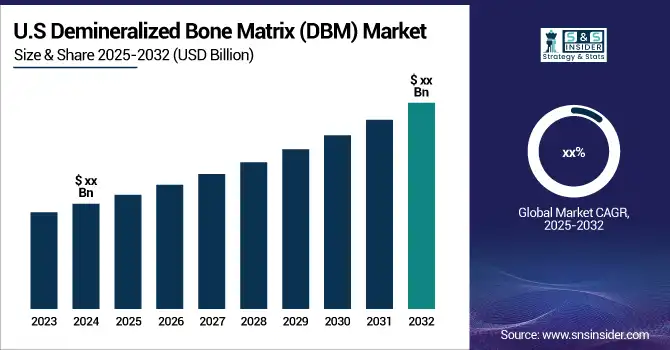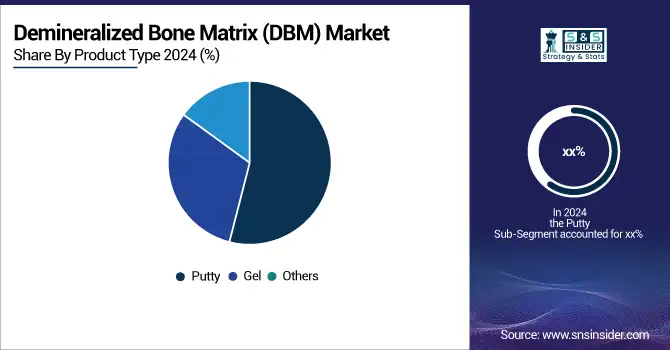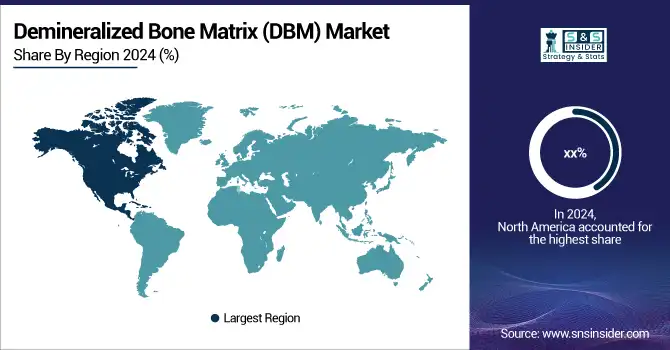Demineralized Bone Matrix (DBM) Market Report Scope and Overview:
The Demineralized Bone Matrix (DBM) Market Size was valued at USD 1.37 billion in 2024 and is projected to reach USD 2.18 billion by 2032 with a growing CAGR of 5.98% Over the Forecast Period of 2025-2032.
The demineralized bone matrix (DBM) market is a dynamic segment within the broader medical and orthopedic industry. DBM is an allogeneic bone-derived bio-implantation material, processed to remove mineral content while retaining essential organic components. The result is a matrix rich in growth factors, collagen and other proteins that promote bone healing and regeneration.
The DBM market has witnessed market growth in recent years due to its applications in various medical fields. It is widely used in orthopedic surgery, spinal fusion procedures, dental surgery and maxillofacial reconstruction. Key driving factors for market expansion include aging of the global population, increasing cases of bone disorders such as osteoporosis and fractures, and advances in surgical techniques emphasizing the biological methods for better patient outcomes.
One of the main benefits of DBM is its ability to stimulate the body's natural healing process. Growth factors and DBM proteins attract osteoblasts, promoting new bone growth at surgical sites. This is especially beneficial in cases where conventional treatments may not yield satisfactory results. DBM also reduces the need for additional invasive procedures because it speeds up bone fusion and reduces recovery time. The market landscape is characterized by the presence of both established medical companies and emerging biotech companies. Key players often engage in research and development activities to improve the effectiveness of DBM products, leading to the introduction of new formulations and delivery systems. These improvements are intended to provide surgeons with a better grip, improved growth factor retention, and an extended release profile.
Regulatory approvals, quality control, and safety standards are key considerations due to the organic nature of the product. The market also faces competition from alternative treatments, such as synthetic bone grafts and tissue engineering approaches. Cost-effectiveness and coverage for DBM procedures are factors that can affect its acceptance rate.
Demineralized Bone Matrix (DBM) Market Size and Forecast:
-
Market Size in 2024: USD 1.37 Billion
-
Market Size by 2032: USD 2.18 Billion
-
CAGR: 5.98% from 2025 to 2032
-
Base Year: 2024
-
Forecast Period: 2025–2032
-
Historical Data: 2021–2023

To Get more information on Demineralized Bone Matrix (DBM) Market - Request Free Sample Report
Demineralized Bone Matrix (DBM) Market Highlights:
-
Aging global population is increasing fractures, bone defects, and spinal disorders, boosting DBM adoption
-
DBM provides osteoinductive and osteoconductive properties, promoting faster healing and serving as an effective alternative to traditional bone grafts
-
Complex processing, sterilization, regulatory compliance, and specialized applications make DBM relatively expensive compared to autografts or synthetic substitutes
-
Elevated costs may limit adoption in cost-sensitive and developing healthcare markets
-
Rising incidence of osteoporosis, spinal deformities, and musculoskeletal injuries creates opportunities for DBM products
-
Aging demographics and lifestyle-related bone health issues drive research, product development, and global market growth

Demineralized Bone Matrix (DBM) Market Drivers:
-
As the global population ages, the incidence of orthopedic conditions such as fractures, bone defects, and spinal disorders rises giving rise to the market.
As the global population continues to age, the prevalence of orthopedic conditions such as fractures, bone defects, and spinal disorders is increasing significantly. This demographic shift is creating a sustained demand for advanced bone grafting and regenerative solutions, particularly demineralized bone matrix (DBM) products. DBM serves as an effective alternative to traditional bone grafts, offering osteoinductive and osteoconductive properties that promote faster healing and bone regeneration. The growing elderly population, combined with a higher rate of musculoskeletal injuries and degenerative bone diseases, is thus a major factor propelling the expansion of the global DBM market over the forecast period.
Demineralized Bone Matrix (DBM) Market Restraints:
-
Compared to other treatment options, DBM products can have a relatively high cost
Compared to other treatment options such as autografts or synthetic bone substitutes, demineralized bone matrix (DBM) products are often associated with relatively high costs. The complex processing, sterilization, and quality assurance procedures required to maintain safety and efficacy contribute significantly to their pricing. Additionally, the costs of regulatory compliance, storage, and specialized surgical applications further increase the overall expense. These higher prices can limit accessibility in cost-sensitive healthcare markets, particularly in developing regions. Consequently, while DBM offers superior regenerative benefits, its elevated cost remains a notable restraint impacting widespread adoption across hospitals and orthopedic treatment centers globally.
Demineralized Bone Matrix (DBM) Market Opportunities:
-
The prevalence of bone-related problems and orthopedic abnormalities is growing worldwide as the population ages.
The prevalence of bone-related problems and orthopedic abnormalities is rising globally as the population ages, leading to an increased demand for effective bone regeneration solutions. Conditions such as osteoporosis, fractures, spinal deformities, and bone defects are becoming more common among the elderly, creating a significant need for advanced biomaterials like demineralized bone matrix (DBM). DBM offers a biologically active and minimally invasive option for bone repair, promoting faster recovery and improved outcomes. The aging demographic, coupled with lifestyle-related bone health issues, is thus a key factor driving the growth and innovation in the global DBM market over the forecast period.
Demineralized Bone Matrix (DBM) Market Segment Analysis:
By Product Type
Among product types, putty-based demineralized bone matrix (DBM) dominates the market due to its superior handling properties, ease of application, and strong osteoconductive capabilities. Gel formulations are also gaining traction for minimally invasive procedures, while the others segment, including chips and strips, caters to specialized surgical needs.

By Application
Among applications, spinal fusion dominates the demineralized bone matrix (DBM) market due to its extensive use in treating spinal deformities and degenerative disc diseases. Dental and joint reconstruction applications are also growing steadily, while craniomaxillofacial, long bone procedures, and others contribute to niche yet expanding clinical areas.
By End User
By End User, hospitals dominate the demineralized bone matrix (DBM) market owing to the high volume of orthopedic and spinal surgeries performed in these settings. Specialty clinics are witnessing steady growth driven by advanced outpatient procedures, while the others segment represents smaller healthcare facilities and research institutions contributing to market expansion.
Demineralized Bone Matrix (DBM) Market Regional Analysis:
North America Demineralized Bone Matrix (DBM) Market Trends:
North America is the dominating market for the DBM Market and will continue to dominate the market over the forecast period. Some of the major factors contributing to the growth of the market are the presence of major companies in this region and rising research and development activities within these companies. The adoption of technologically advanced products is another contributing factor to the growth of the market. Furthermore, the strong demand for these products due to the increased awareness related to these products will give a boost to the growth of the market.

Get Customized Report as per Your Business Requirement - Enquiry Now
Europe Demineralized Bone Matrix (DBM) Market Trends:
Europe represents a significant share of the global demineralized bone matrix market, driven by the growing prevalence of orthopedic disorders and an aging population. The region benefits from advanced healthcare infrastructure, increased investment in regenerative medicine, and rising adoption of innovative bone grafting materials. Government initiatives supporting healthcare innovation and favorable reimbursement policies further enhance market growth. Additionally, collaborations between research institutions and biotechnology firms are accelerating product development, while countries such as Germany, the U.K., and France remain key contributors to Europe’s DBM market expansion over the forecast period.
Asia-Pacific Demineralized Bone Matrix (DBM) Market Trends:
Asia-Pacific is the fastest-growing region in the demineralized bone matrix market, fueled by a rapidly aging population and rising incidence of bone-related disorders. Increasing healthcare expenditure, improving medical infrastructure, and growing awareness of advanced grafting materials are propelling market expansion. Countries such as China, Japan, India, and South Korea are witnessing higher adoption of DBM products in orthopedic and spinal surgeries. Moreover, the presence of local manufacturers offering cost-effective solutions and the rising number of trauma and accident cases are further driving demand across the Asia-Pacific region.
Latin America Demineralized Bone Matrix (DBM) Market Trends:
The Latin America demineralized bone matrix market is steadily expanding due to improving healthcare access, growing awareness about bone regeneration therapies, and a rising prevalence of osteoporosis and fractures. Brazil and Mexico are leading contributors, supported by expanding orthopedic care facilities and increasing use of biomaterials in surgeries. The region is also benefiting from international collaborations and imports of advanced DBM products. However, high treatment costs and limited reimbursement coverage in some countries remain challenges, although ongoing healthcare modernization is expected to support continued market growth.
Middle East & Africa Demineralized Bone Matrix (DBM) Market Trends:
The Middle East & Africa market for demineralized bone matrix is experiencing gradual growth, driven by increasing investments in healthcare infrastructure and a rising burden of bone injuries and degenerative diseases. Countries such as the UAE, Saudi Arabia, and South Africa are leading market growth due to growing medical tourism and adoption of advanced orthopedic treatments. International partnerships with global DBM manufacturers are enhancing technology transfer and product availability. Although market penetration remains lower compared to other regions, improving healthcare systems and awareness are expected to boost future demand.
Demineralized Bone Matrix (DBM) Market Key Players:
-
Medtronic
-
Johnson & Johnson (DePuy Synthes)
-
Zimmer Biomet
-
Stryker
-
Xtant Medical
-
RTI Surgical
-
SeaSpine
-
Hans Biomed
-
Arthrex GmbH
-
Exactech, Inc.
-
Institut Straumann AG
-
Globus Medical
-
LifeNet Health
-
Orthofix Holdings Inc.
-
MTF Biologics
-
Kuros Biosciences
-
AlloSource
-
Royal Biologics
-
Bone Bank Allografts
-
Bioventus
Demineralized Bone Matrix (DBM) Market Competitive Landscape:
Johnson & Johnson MedTech, established in 1886, is a global leader in orthopaedic technologies, specializing in joint reconstruction, spine, trauma, and extremities solutions. The company develops innovative surgical systems, robotics, and implants, focusing on improving patient outcomes, precision, and efficiency while maintaining a comprehensive portfolio of medtech solutions worldwide.
-
In November 2024, At the AAHKS 2024 Annual Meeting, J&J showcased its VELYS™ Robotic-Assisted Solution, WATSON EXTRACTION SYSTEM™, and CUPTIMIZE™ Hip-Spine Analysis, advancing precision joint reconstruction and improving patient outcomes.
Stryker Corporation, established in 1941, is a global leader in medical technologies, specializing in orthopaedics, surgical equipment, neurotechnology, and spine solutions. The company focuses on innovative medical devices, patient care, and sustainability initiatives, driving improved clinical outcomes and advancing healthcare worldwide through cutting-edge products and solutions.
-
In April 2025, Stryker highlighted a year of innovation, growth, and impact, showcasing transformative product launches like the Pangea Plating System and LIFEPAK 35, while advancing sustainability and global MedTech initiatives.
| Report Attributes | Details |
|---|---|
| Market Size in 2024 | USD 1.37 Billion |
| Market Size by 2032 | USD 2.18 Billion |
| CAGR | CAGR of 5.98% From 2025 to 2032 |
| Base Year | 2024 |
| Forecast Period | 2025-2032 |
| Historical Data | 2021-2023 |
| Report Scope & Coverage | Market Size, Segments Analysis, Competitive Landscape, Regional Analysis, DROC & SWOT Analysis, Forecast Outlook |
| Key Segments | • By Product Type (Gel, Putty, Others) • By Application (Dental, Spinal Fusion, Joint Reconstruction, Craniomaxillofacial, Long Bone Procedures, Others) • By End User (Speciality Clinics, Hospitality, Others) |
| Regional Analysis/Coverage | North America (US, Canada), Europe (Germany, UK, France, Italy, Spain, Russia, Poland, Rest of Europe), Asia Pacific (China, India, Japan, South Korea, Australia, ASEAN Countries, Rest of Asia Pacific), Middle East & Africa (UAE, Saudi Arabia, Qatar, South Africa, Rest of Middle East & Africa), Latin America (Brazil, Argentina, Mexico, Colombia, Rest of Latin America). |
| Company Profiles | Medtronic, Johnson & Johnson (DePuy Synthes), Zimmer Biomet, Stryker, Xtant Medical, RTI Surgical, SeaSpine, Hans Biomed, Arthrex GmbH, Exactech, Inc., Institut Straumann AG, Globus Medical, LifeNet Health, Orthofix Holdings Inc., MTF Biologics, Kuros Biosciences, AlloSource, Royal Biologics, Bone Bank Allografts, Bioventus. |

